
A musical ensemble, also known as a music group or musical group, is a group of people who perform instrumental and/or vocal music, with the ensemble typically known by a distinct name. Some music ensembles consist solely of instrumentalists, such as the jazz quartet or the orchestra. Other music ensembles consist solely of singers, such as choirs and doo-wop groups. In both popular music and classical music, there are ensembles in which both instrumentalists and singers perform, such as the rock band or the Baroque chamber group for basso continuo and one or more singers. In classical music, trios or quartets either blend the sounds of musical instrument families or group instruments from the same instrument family, such as string ensembles or wind ensembles. Some ensembles blend the sounds of a variety of instrument families, such as the orchestra, which uses a string section, brass instruments, woodwinds, and percussion instruments, or the concert band, which uses brass, woodwinds, and percussion.

A song is a musical composition performed by the human voice. The voice often carries the melody using patterns of sound and silence. Songs have a structure to them, such as the common ABA form, and are usually made of sections that are repeated or performed with variation later. A song without instruments is said to be a cappella.
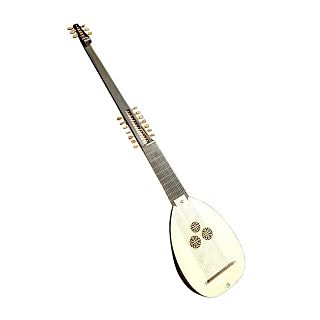
The theorbo is a plucked string instrument of the lute family, with an extended neck that houses the second pegbox. Like a lute, a theorbo has a curved-back sound box with a flat top, typically with one or three sound holes decorated with rosettes. As with the lute, the player plucks or strums the strings with the right hand while "fretting" the strings with the left hand.

Traditional Vietnamese music encompasses a large umbrella of Vietnamese music from antiquity to present times, and can also encompass multiple groups, such as those from Vietnam's ethnic minority tribes.

The biwa is a Japanese short-necked wooden lute traditionally used in narrative storytelling. The biwa is a plucked string instrument that first gained popularity in China before spreading throughout East Asia, eventually reaching Japan sometime during the Nara period (710–794). Typically 60 centimetres (24 in) to 106 centimetres (42 in) in length, the instrument is constructed of a water drop-shaped body with a short neck, typically with four strings. In Japan, the biwa is generally played with a bachi instead of the fingers, and is often used to play gagaku. One of the biwa's most famous uses is for reciting The Tale of theHeike, a war chronicle from the Kamakura period (1185–1333). In previous centuries, the predominant biwa musicians would have been blind monks, who used the biwa as musical accompaniment when reading scriptural texts.

The đàn bầu, also called độc huyền cầm is a Vietnamese stringed instrument, in the form of a monochord (one-string) zither.

Ca trù, also known as hát cô đầu or hát nói, is a Vietnamese genre of musical storytelling performed by a featuring female vocalist, with origins in northern Vietnam. For much of its history, it was associated with a pansori-like form of entertainment, which combined entertaining wealthy people as well as performing religious songs for the royal court.
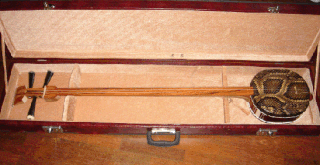
The sanxian is a three-stringed traditional Chinese lute. It has a long fretless fingerboard, and the body is traditionally made from snake skin stretched over a rounded rectangular resonator. It is made in several sizes for different purposes and in the early 20th century a four-stringed version, the jiaxian sanxian (加弦三弦), was developed. The northern sanxian is generally larger, at about 122 cm (48 in) in length, while southern versions of the instrument are usually about 95 cm (37 in) in length.
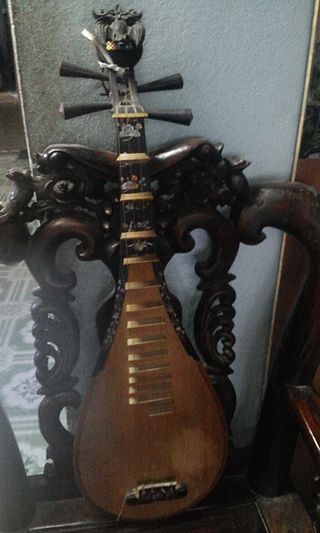
The đàn tỳ bà is a Vietnamese traditional plucked string instrument derived form the Chinese pipa, That first gained popularity in China before spreading throughout East Asia, eventually reaching Vietnam sometime during the Trần dynasty.

The đàn nguyệt also called nguyệt cầm, đàn kìm, is a two-stringed Vietnamese traditional musical instrument. It is used in folk and classical music and remains popular throughout Vietnam. It may be descended from the Ruan, a Chinese instrument.

During the reign of Queen Elizabeth I (1558–1603), English art and high culture reached a pinnacle known as the height of the English Renaissance. Elizabethan music experienced a shift in popularity from sacred to secular music and the rise of instrumental music. Professional musicians were employed by the Church of England, the nobility, and the rising middle-class.

The đàn tranh or đàn thập lục is a plucked zither of Vietnam, based on the Chinese guzheng, from which are also derived the Japanese koto, the Korean gayageum and ajaeng, the Mongolian yatga, the Sundanese kacapi and the Kazakh jetigen. It has a long soundbox with the steel strings, movable bridges and tuning pegs positioned on its top.
Traditional Vietnamese musical instruments are the musical instruments used in the traditional and classical musics of Vietnam. They comprise a wide range of string, wind, and percussion instruments, used by both the Viet majority as well as the nation's ethnic minorities.
Jiangnan sizhu is a style of traditional Chinese instrumental music from the Jiangnan region of China.
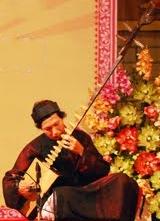
The đàn đáy is a Vietnamese plucked lute with three strings, a trapezoidal wooden body, and a very long wooden neck with ten raised frets. Players formerly used silk strings, but since the late 20th century have generally used nylon.

Nhã nhạc is a traditional music of Vietnam. Vietnamese court music is very diverse, but the term nhã nhạc refers specifically to the Vietnamese court music performed from the Trần dynasty of the 13th century to the Nguyễn dynasty at the end of the 20th century.

Theatre of Vietnam comprises many traditional forms of drama which survive and retain their popularity to varying degrees. It formed during the Đinh dynasty, when the Đại Cồ Việt state was born. Water puppetry is a distinctively Vietnamese art form which arose in the 12th century in which a split-bamboo screen obscures puppeteers, who stand in water manipulating the puppets in front of the screen using long poles. Water puppetry is currently popular with tourists to Vietnam. With the success of the August Revolution in 1945, theatrical art entered a new creative period including a new type of theater based on the music of local folk tunes.
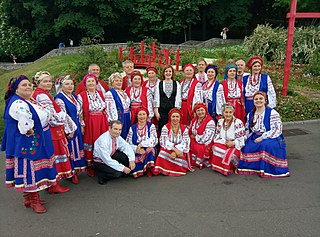
Ukrainian folk music includes a number of varieties of traditional, folkloric, folk-inspired popular music, and folk-inspired European classical music traditions.
Trần Thị Minh Tuyết better known as Minh Tuyết, is a Vietnamese-American pop singer, currently performing on Thúy Nga's Paris by Night. Her sisters are Cẩm Ly and Hà Phương who perform with her as part of the cast of Paris by Night. She is known in the Vietnamese American culture as the Vietnamese Pop Princess. Her real name is Trần Thị Minh Tuyết, which in English literally means "Morning Snow."
Phạm Thị Huệ is a Vietnamese đàn bầu, đàn đáy, and đàn tỳ bà player, singer, composer and educator. She is the founder and owner of the Thăng Long Ca trù Theater in the Hanoi historic district and has become a leading exponent in the revival of ca trù singing throughout Vietnam.


















